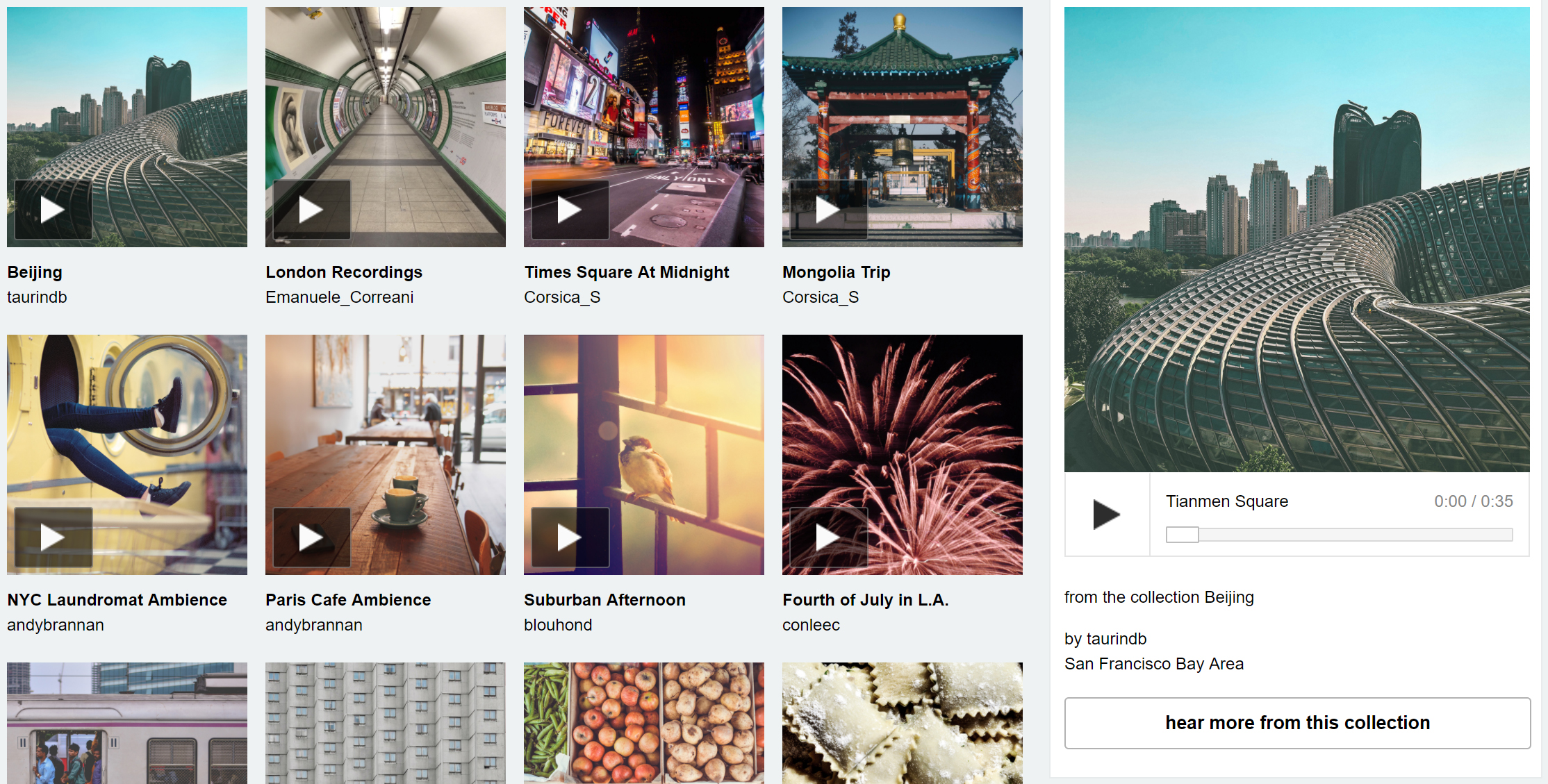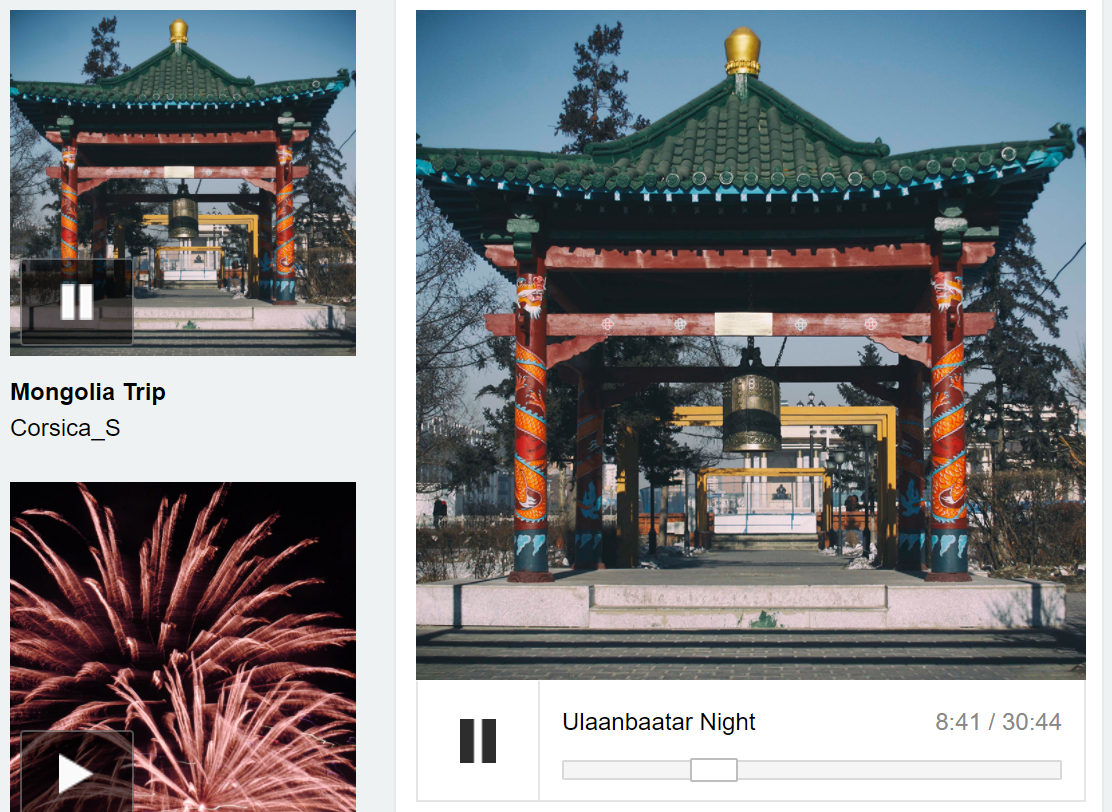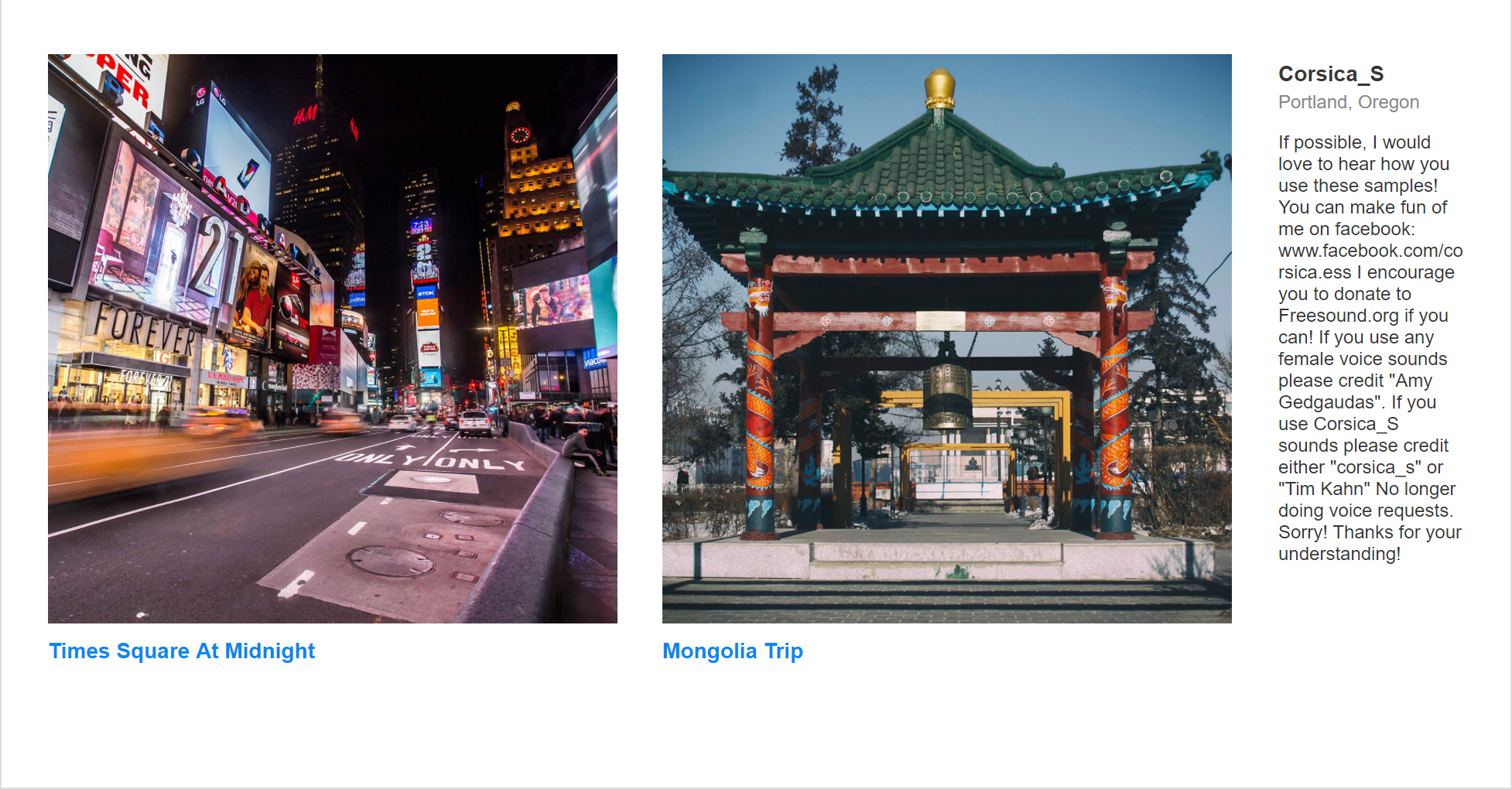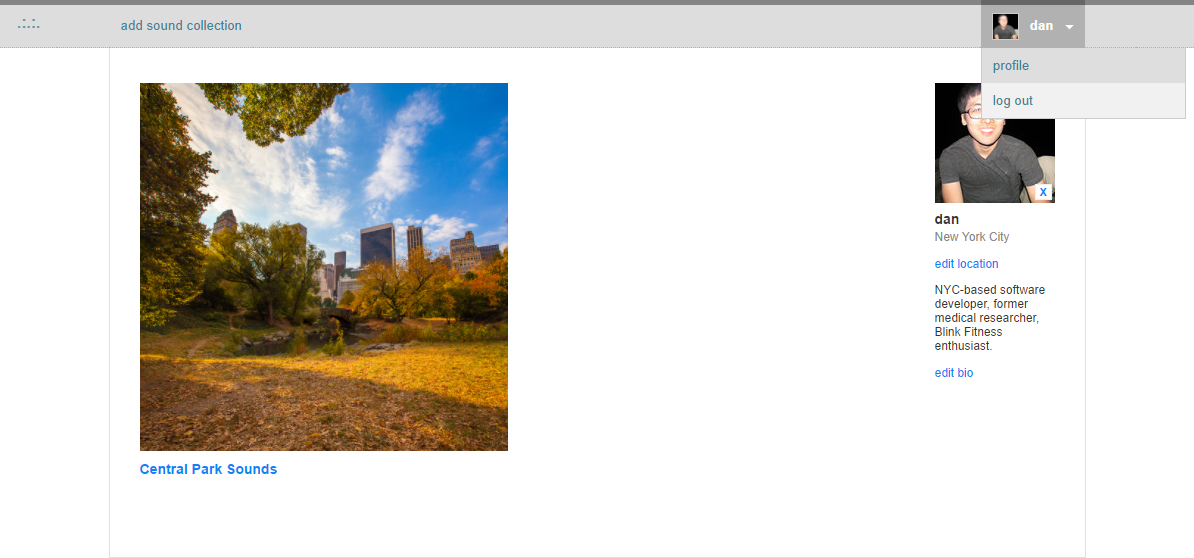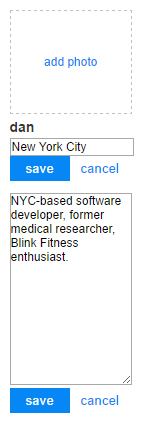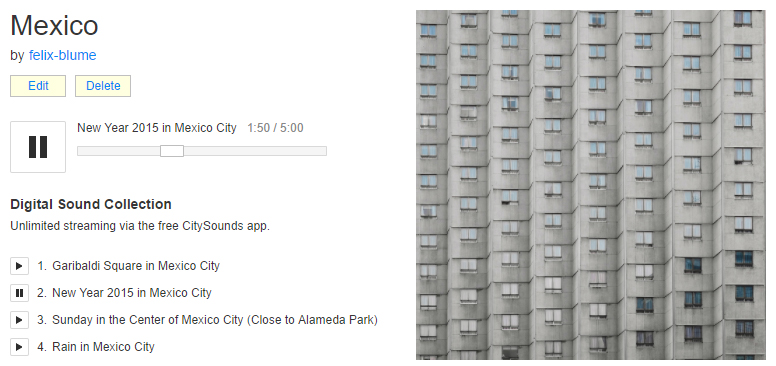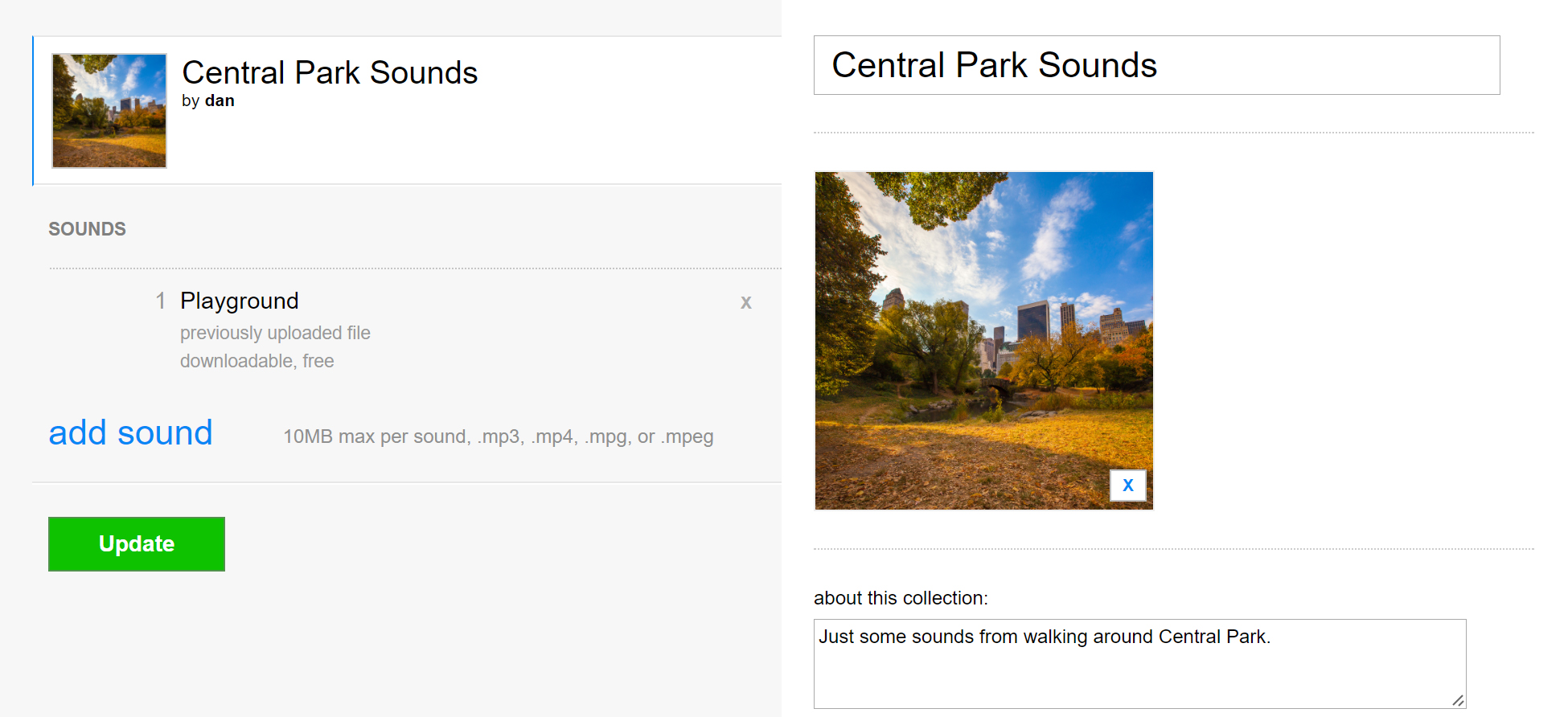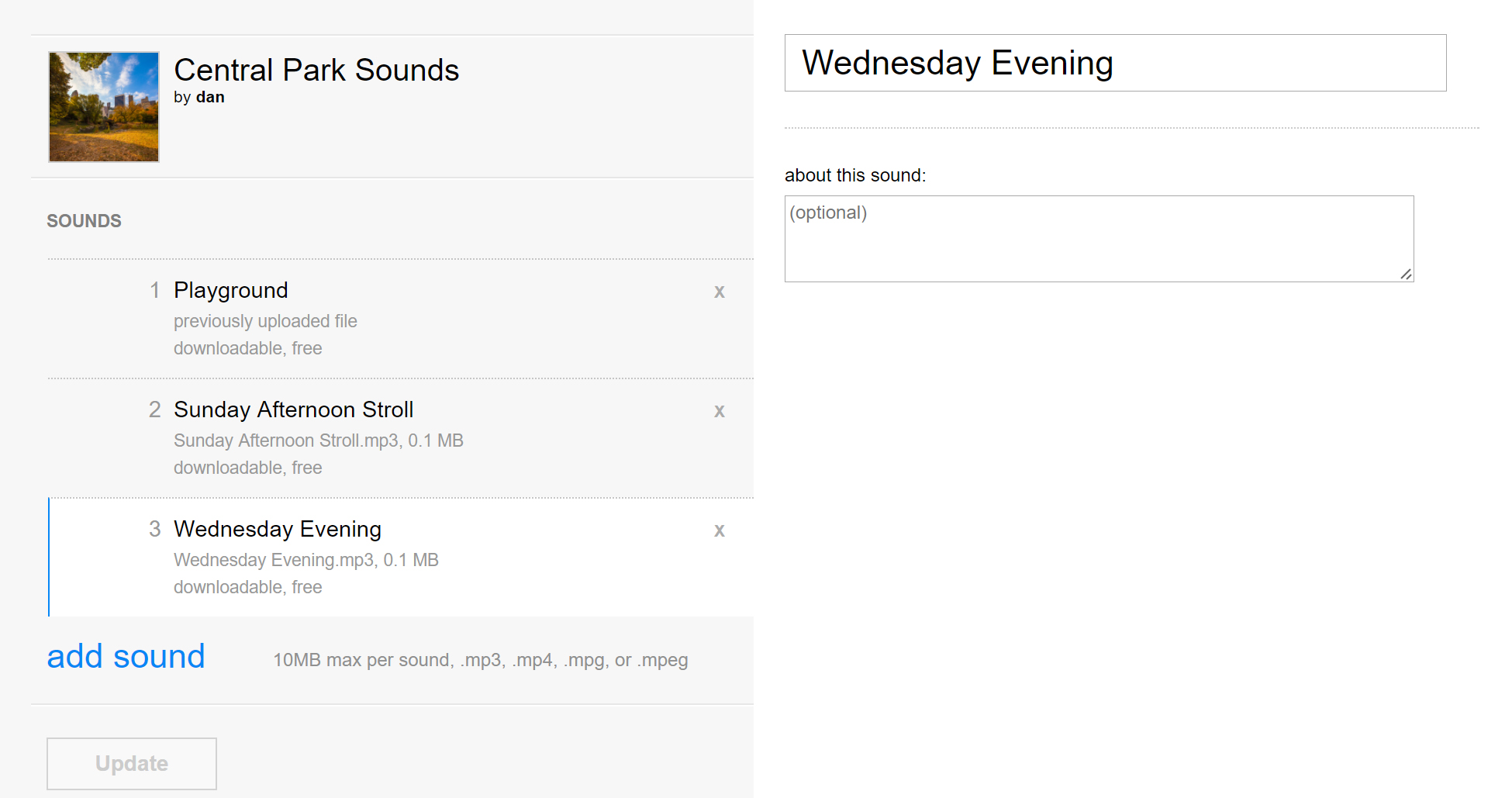CitySounds is a full-stack web application for sharing and playing ambient city soundscapes. Based on Bandcamp, it utilizes Ruby on Rails with PostgreSQL on the backend and React.js with Redux on the frontend.
CitySounds allows visitors to browse through other users' collections and listen to sounds. Users who are logged in can also create, edit, and delete sound collections. In order to achieve this, I used three primary ActiveRecord models:
usercollection(analogous to analbum)sound(analogous to atrack)
At the PostgreSQL database level, a user is stored in a users table with the following columns:
idusernamebio(optional)location(optional)- Authentication information
In addition, avatar images are handled by the paperclip gem and stored on Amazon Simple Storage Service (S3).
The collections SQL table has the following columns:
idtitleuser_id(foreign key)description(optional)
In addition, avatar images are stored on Amazon S3 via paperclip.
The sounds SQL table has the following columns:
idtitlecollection_id(foreign key)description(optional)
In addition, audio files are stored on Amazon S3 via paperclip.
Upon entering the homepage, an AJAX request is made to fetch all collection objects, which are then rendered as ExploreListItem React components in the Explore section. Next to this is the ExploreSoundPlayer component, which utilizes ReactAudioPlayer to allow my custom-styled HTML elements to control audio playback. By default, the first sound of the first collection is loaded into the ExploreSoundPlayer state.
To enable the user to switch seamlessly between SoundCollections, I put the audio playback state into the Explore component and connected it not only to the ExploreSoundPlayer (code snippet below), but also to the ExploreList, so that each ExploreListItem could conditionally style its play/pause button.
<ExploreSoundPlayer
sound={ this.state.playingSound }
playing={ this.state.playing }
playPauseAudio={ this.playPauseAudio }
playedYet={ this.state.playedYet }
setPlayedYet={ this.setPlayedYet } />Each ExploreListItem in the homepage contains links to the collection author's profile page. Both visitors who aren't logged in and users browsing someone else's profile see a simple static profile page.
Users who are logged in see a personalized NavBarContainer and—if on their own profile page—sidebar links to edit their avatar image, location, and bio.
The UserSidebarContainer on the right is further divided into three dynamic sub-components:
UserSidebarAvatarUserSidebarLocationUserSidebarBio
The UserSidebarContainer state keeps track of which, if any, of the avatar/location/bio fields are being edited (code snippet below) and passes that information to the corresponding sub-component.
this.state = {
avatarFile: null,
avatarUrl: this.props.user.avatarUrl,
location: this.props.user.location,
bio: this.props.user.bio,
editingLocation: false,
editingBio: false
};When a link is clicked within a sub-component, the static <image> or <p> element is replaced with appropriate <input> elements and, if applicable, <button> elements to save/cancel.
Uploading an avatar image or saving a new location/bio immediately dispatches a thunk action that sends an AJAX PATCH request to the backend, receives the new user and currentUser, and updates the Redux state—thus forcing the UserSidebarContainer and NavBarContainer to re-render with the new user information.
The sound collection page renders a CollectionSoundPlayer functionally identical to the ExploreSoundPlayer on the home page, except that there are SoundListItems for each sound in the collection instead of the ExploreListItems on the homepage. If the collection belongs to the currentUser, then Edit/Delete links are also available.
The CollectionFormContainer renders a multi-tabbed component consisting of a primary CollectionFormCollectionSubForm sub-component, plus additional CollectionFormSoundSubForm sub-components for each sound file uploaded. The CollectionForm state (code snippet below) centralizes the information necessary to switch between tabs.
this.state = {
artworkFile: null,
artworkUrl: '/avatars/original/missing.png',
sounds: [],
soundsToDelete: [],
title: '',
description: '',
currentForm: null,
currentFormIdx: -1,
submitted: false,
};If the currentFormIdx is -1, the CollectionFormCollectionSubForm is rendered.
If the currentFormIdx is 0 or greater, a CollectionFormSoundSubForm is rendered using sounds[currentFormIdx], which is an array of SoundListItems.
Submitting the form sends a single AJAX POST/PATCH request, pooling the collection and sound data together. In order to enforce database integrity, the backend groups the collection and sound actions into a single ActiveRecord::Base.transaction (code snippet below) in order to enforce database integrity.
def create
@collection = Collection.new(collection_params)
begin
ActiveRecord::Base.transaction do
if @collection.save
parse_and_save_sounds
render 'api/collections/show'
else
render json: @collection.errors, status: 422
end
end
rescue ActiveRecord::RecordInvalid => exception
render json: { sounds: exception.message[19..-1].split(', ') }, status: 422
rescue NoSoundsError => exception
render json: { sounds: ['Must have at least one sound.'] }, status: 422
end
end
def update
@collection = Collection.find(params[:id])
begin
ActiveRecord::Base.transaction do
if @collection.update(collection_params)
parse_and_save_sounds
render 'api/collections/show'
else
render json: @collection.errors, status: 422
end
end
rescue ActiveRecord::RecordInvalid => exception
render json: { sounds: exception.message[19..-1].split(', ') }, status: 422
rescue NoSoundsError => exception
render json: { sounds: ['Must have at least one sound.'] }, status: 422
end
endCollections and Sounds are searched by title and description using the pg-search gem.
CitySounds is still a work in progress! Here are some of the next steps.
Bandcamp allows fans to add albums/tracks to their wishlist, which can later be revisited. A similar "liked sounds" and "playlist" functionality on CitySounds would make it much more appealing to users.
On Bandcamp's homepage, featured albums can be filtered by genres such as rock, alternative, hip-hop/rap, etc. A similar tagging & filtering system would translate over very naturally to CitySounds; some possible tags might include cafe, rain, china, etc.
As CitySounds grows, fetching all collection objects for the homepage will become increasingly slow. Returning a small number of collection objects per query would be a natural first step in scaling up. In addition, several of the AJAX calls to the backend can reasonably be consolidated together.
